Frank Atwood Huntington
| Frank Atwood Huntington | |
|---|---|
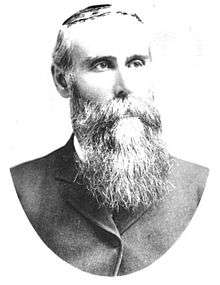 Frank Atwood Huntington, 1891 | |
| Born |
August 9, 1836 Atkinson, Maine |
| Died |
February 16, 1925 (aged 88) Oakland, California |
| Nationality | American |
| Occupation | Engineer |
| Spouse(s) |
Laura Caroline Folzer, married February 22, 1872 |
| Children |
Marie Louise (b. 9/18/1873) (d. 6/22/1895) |
| Parent(s) |
Joseph Huntington Mary Babb Huntington |
| Engineering career | |
| Practice name | F. A. Huntington |
| Projects |
misc inventions for mining machinery |
| Significant design |
gasoline powered vehicle centrifugal roller mill |
| Significant advance |
mining equipment patents many mining innovations |
| Awards | At least two dozen various registered patents |
Frank Atwood Huntington (August 9, 1836 – February 16, 1925) was an American inventor.[1]
Biography
Huntington was born in Atkinson, Maine on August 9, 1836. He had twelve siblings, being number thirteen and the last child born in the family.[2] Huntington's ancestors were interested in the lumber trade. His father owned a sawmill and a shingle mill. What he learned in his youth was reflected in his innovations and patents later.[1]
Huntington at the age of twenty-one went to San Francisco.[3] In 1858 he took charge of a lumber mill in Monterey County, California. He later managed a shingle mill in nearby San Mateo County. While there the inadequacy of the sawmill machinery gave him ideas for improvements to shingle machines. He later obtained patents for his innovations in improvements to sawmill machinery.[1]
Sometime in the early part of the 1860s Huntington went to Humboldt County, Nevada and tried mining for a while. He had varying degrees of success. Later he went to Arizona. After years of adventure in Arizona and other places and not succeeding as well as he wished, he gave up mining and returned to San Francisco. Here he commenced to make good use of his inventive skills and in 1865 began to manufacture sawmill machinery. He introduced a number of improvements to sawmill machinery which he patented.[1]
When he moved back to San Francisco he first was located in the Pacific Saw Company's Building in San Francisco where he remained three or four years until 1870. He shows up in the 1870 San Francisco census. From time to time he moved his headquarters of mining machinery to the Kittredge Building and to the Vulcan Iron Works in San Francisco.[1] He is then found at 45 Fremont Street and later at 213 to 219 First Street in San Francisco.[4]
On September 18, 1873, Huntington married Laura Caroline Folzer. They had one child, a daughter named Marie Louise. They lived at Webster and Durant streets in Oakland. Huntington was a family man and spent his leisure time with his wife and daughter at their elegant home.[3] From time to time he had Chinese servants at his home.[5]
Self-propelled vehicle
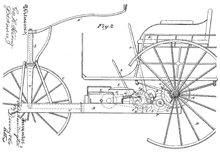
In 1889 Huntington patented a gasoline engine propelled vehicle,[6] four years before the Duryea brothers built and tested their first vehicle in Springfield, Massachusetts, in 1893[7] — considered by many as the first American[8] gas powered car.[9][10] It is likely Huntington was the first inventor of a gasoline engine car on the west coast of the United States.[11][12] While it is not known whether Huntington’s vehicle was successfully built,[13] his patent 411196 has certain claims that represent a self-propelled gasoline engine car.[6]
My invention relates to certain improvements in vehicles; and it consists of an engine and suitable intermediate gearing whereby the vehicle may be propelled…
This invention is designed to apply a gasoline or other vapor engine to an ordinary carriage or road vehicle, with frictional mechanism for transmitting power, changing the speed of the forward movement of the vehicle and reversing the motion of the vehicle at will.
The vehicle mounted upon independent driving and steering wheels, independent gears by which each of the driving-wheels is propelled, a divided counter-shaft having a frictional drum and a differential gear, where by the wheels may be driven independently at different speeds, in combination with an engine, an engine-shaft provided with a corresponding friction drum, and a movable frame supporting an intermediate friction-drum between the drums upon the counter-shaft; and the engine-shaft, and a lever, whereby said intermediate drum may be turned into or out of contact with the others, substantially as described.[6]
Patents
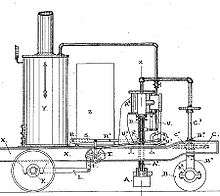
In the years he was in California he experimented incessantly with machinery. He gave to the public various inventions of practical value. Besides being a practical inventor he was also a manufacturer of his special machinery. In 1891 he was experimenting on what was considered a most important invention.[1]
- 1868 - IMPROVED CARRIAGE-SPRING.[14]
- 1872 - IMPROVEMENT IN STEAM-BOILER FURNACES.[15]
- 1872 - IMPROVEMENT IN BALING-PRESSES.[16]
- 1873 - IMPROVEMENT IN DIVIDED-NUT DEVICES FOR FEED-SCREWS.[17]
- 1874 - IMPROVEMENT IN SHINGLE-MACHINES.[18]
- 1874 - IMPROVEMENT IN MAGAZINE FIRE-ARMS.[19]
- 1878 - IMPROVEMENT IN ORE-STAMPS.[20]
- 1880 - FEED AND SET WORKS FOR SAW-MILLS [21]
- 1889 - VEHICLE.[6]
- 1891 - POWER STREET-PAVING MACHINE.[22]
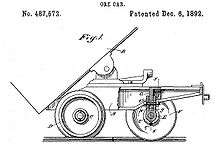
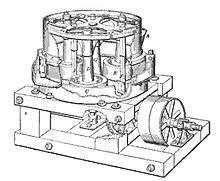
His mining experience gave him the idea for a roller quartz mill, improved ore crushers, concentrators and many other needed mining equipment improvements of older mining machinery. It is inventions like his that made San Francisco the center of the manufacture of mining machinery for the United States.[1]
- 1880 - ORE CRUSHER AND PULVERIZER.[23]
- 1880 - AMALGAMATOR.[24]
- 1881 - ORE-FEEDER FOR CRUSHING-MILLS.[25]
- 1881 - GRINDING AND AMALGAMATING PAN.[26]
- 1882 - CRUSHING MILL.[27]
- 1885 - ROCK CRUSHER OR BREAKER.[28]
- 1885 - CRUSHING MILL.[29]
- 1887 - ORE-CRUSHER.[30]
- 1888 - ORE-FEEDER.[31]
- 1890 - CRUSHING-MILL.[32]
- 1890 - CRUSHING-MILL.[33]
- 1891 - ORE-FEEDER FOR CRUSHING-MILLS.[34]
- 1892 - ORE-CAR.[35]
- 1896 - CRUSHING-MILL.[36]
- 1898 - ROLLER CRUSHING-MILL.[37]
- 1908 - CRUSHING-MILL.[38]
Associations and Society Clubs
- Member of the National Association of Manufacturers.
- Member of the Mechanics' Institute.
- Member of the Keystone Lodge.
- Member of the Knights of Honor.
See also
Footnotes
- 1 2 3 4 5 6 7 The Journal, p. 219
- ↑ Family Search Archived December 12, 2008, at the Wayback Machine.
- 1 2 HFA, Huntington genealogy, p. 54
- ↑ According to AncestoryLibrary.com based on San Francisco Directories, 1889-91, W.H.L. Corran, 1889 and Painter and Co. Publishing, 1890.
- ↑ Per 1910 and 1920 U.S. Census
- 1 2 3 4 Patent number: 411196
- ↑ "The Duryea Brothers". About.com.
- ↑ "Duryea claims first gas-powered ride". History.com.
- ↑ "Charles Edgar Duryea". Find A Grave.
- ↑ "On this Day: America's First Gas-Powered Car Gets Test Drive". Finding Dulcinea.
- ↑ Kimes. p. 751.
Quite possibly, Frank A. Huntington was the first inventor on the West Coast to patent an automobile.
Missing or empty|title=(help) - ↑ . Amos Press. p. 16.
The first patent (January 11, 1889) for a gasoline vehicle, went to Frank A. Huntington, of San Francisco, California.
Missing or empty|title=(help) - ↑ Scharchburg. p. 30. Missing or empty
|title=(help) - ↑ Patent number: 85008
- ↑ Patent number: 132209
- ↑ Patent number: 126394
- ↑ Patent number: 143626
- ↑ Patent number: RE6082
- ↑ Patent number: 150102
- ↑ Patent number: 210610
- ↑ Patent number: 245632
- ↑ Patent number: 452184
- ↑ Patent number: 236333
- ↑ Patent number: 359155
- ↑ Patent number: 246392
- ↑ Patent number: 251442
- ↑ Patent number: 277134
- ↑ Patent number: 324937
- ↑ Patent number: 325804
- ↑ Patent number: 356044
- ↑ Patent number: 392562
- ↑ Patent number: 419256
- ↑ Patent number: 427690
- ↑ Patent number: 246392
- ↑ Patent number: 487572
- ↑ Patent number: 556466
- ↑ Patent number: 648960
- ↑ Patent number: 879175
Sources
- Amos Press, Cars & Parts, Item notes: v.33 1990 Jul-Dec, 1990
- Huntington Family Association (HFA), THE HUNTINGTON FAMILY IN AMERICA, A Genealogical Memoir of the Known Descendants of SIMON HUNTINGTON from 1633 to 1915, The Hartford Printing Company, Hartford, Connecticut, 1915
- Kimes, Beverly Rae et al., Standard Catalog of American Cars, 1805-1942, Krause Publications, 1996, ISBN 0-87341-428-4
- Scharchburg, Richard P., Carriages Without Horses
- The Journal, The Builders of a Great City: San Francisco's Representative Men, the City, Its History and Commerce : Pregnant Facts Regarding the Growth of the Leading Branches of Trade, Industries and Products of the State and Coast, San Francisco Journal of Commerce, 1891